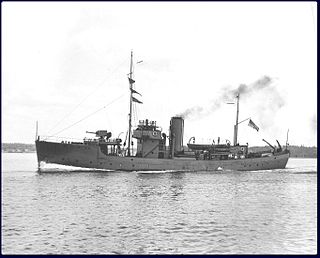Several Canadian naval units have been named HMCS Nootka.
Several Canadian naval units have been named HMCS Winnipeg.

HMCS Alberni was a Flower-class corvette that served in the Royal Canadian Navy (RCN) during the Second World War. She served in several theatres of the war. She was sunk in 1944.

HMCS Nootka was a Fundy-class minesweeper that served in the Royal Canadian Navy from 1938–1945. She saw service during the Second World War as a local minesweeper working out of Halifax, Nova Scotia. She was named for Nootka Sound. In 1943 she was renamed HMCS Nanoose to allow the unit name Nootka to be used by the destroyer HMCS Nootka. Following the war the ship was sold for mercantile use, becoming the tugboat Sung Ling. The ship's registry was deleted in 1993.
Three Canadian naval units have carried the name HMCS Miramichi.

HMCS Charlottetown was a Flower-class corvette that served the Royal Canadian Navy during the Second World War. Charlottetown's pennant number K244 is unique in that it was also used for HMCS Charlottetown, a River-class frigate.
A motor minesweeper is a small minesweeper, powered by an internal combustion engine, very often of wooden construction, designed to locate and destroy mines in coastal waters and harbors. Many navies have used such ships.
The Royal Canadian Navy uses hull classification symbols to identify the types of its ships, which are similar to the United States Navy's Hull classification symbol system. The Royal Navy and some European and Commonwealth navies use a somewhat analogous system of Pennant numbers.
HMCS Miramichi was a Bangor-class minesweeper that served in the Royal Canadian Navy during the Second World War. She remained on the west coast of Canada for the entirety of the war. She was named for Miramichi, New Brunswick. After the war she was purchased with the intent of conversion for mercantile use. However, that never took place and instead, she was scrapped in 1949.
Several Canadian naval units have been named HMCS Chaleur.
Several Canadian naval units have carried the name HMCS Champlain:

The Fundy-class minesweepers were a class of four minesweepers operated by the Royal Canadian Navy during the Second World War. All four ships entered service in 1938 and the class were discarded in 1945, sold for mercantile service. Three ended up sold to Chinese interests, while one remained active in Canada until 1987.

HMCS Comox was a Fundy-class minesweeper that served in the Royal Canadian Navy from 1938–1945. She served during the Second World War as a local patrol craft for Esquimalt, British Columbia before transferring to Halifax, Nova Scotia performing general minesweeping duties. After the war she sold for mercantile service and converted to a tugboat named Sung Ming. The ship's registry was deleted in 1993.
HMCS Comox was a Bay-class minesweeper built for the Royal Canadian Navy during the Cold War. The vessel was named for Comox Harbour, a bay in British Columbia. The minesweeper was later transferred to the Turkish Navy where she was renamed Tirebolu and served until 1996.

HMCS Fundy was a Fundy-class minesweeper that served in the Royal Canadian Navy from 1938 to 1945. The minesweeper was the first warship built for Canada since 1918. She saw service in the Atlantic Ocean during the Second World War. The vessel was named for the Bay of Fundy. After the war she had an extensive civilian career.
Several Canadian naval units have been named HMCS Anticosti.
HMCS Kentville was a Bangor-class minesweeper that served in the Royal Canadian Navy during the Second World War. She saw action in the Battle of the Atlantic. She was named for Kentville, Nova Scotia. After the war she was recommissioned for a short period with the Royal Canadian Navy before being sold to Turkey in 1957 and renamed Bartin. She served with the Turkish Naval Forces until 1972.
Several units of the Royal Canadian Navy have been named HMCS Granby.
Three Canadian naval units have been named HMCS Fundy.
HMCS James Bay was a Bay-class minesweeper that was constructed for the Royal Canadian Navy during the Cold War. Entering service in 1954, the ship served on the West Coast of Canada until 1964 when James Bay was decommissioned. The minesweeper was sold in 1966 for use as an offshore oil exploration vessel.
This page is based on this
Wikipedia article Text is available under the
CC BY-SA 4.0 license; additional terms may apply.
Images, videos and audio are available under their respective licenses.





